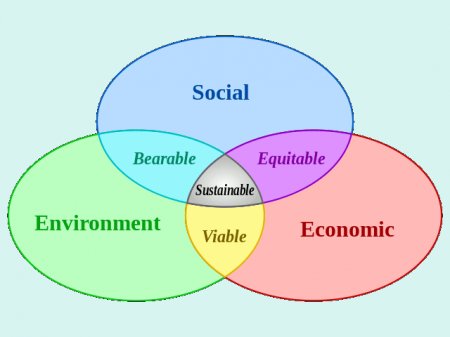-
The sustainable development
-
The sustainable development
All human activities, without exception, now generate damages to the environment. It has not always been that way since before the beginning of the industrial age in the 18th century, the man exercised no known constraints on the environment.

Source of photograph : Barbara Streisand
The man, the environment and the enterprises
Définition of sustainable development
What does sustainable development and corporate social responsibility?
According to Brundtland Commission report definition: "It is development that meets the needs of present generations without compromising the ability of future generations to meet their own needs."
At its inception in 1968, the "Club de Rome" takes the evolution matter of the world as a whole in an attempt to determine the limits of growth. Almost three decades later, in 2005, comes into force Kyoto's protocol on reducing emissions of greenhouse gases.
The global ecological footprint has exceeded the biological capacity of the land to recover. For some analysts, the depletion of natural resources, the fragmentation or destruction of ecosystems and the loss of biodiversity decrease the resilience of the planet.
Objectives of sustainable development
They are numerous:
- The satisfaction of basic needs for present and future communities,
- Improving the quality of life,
- Respect for the rights and freedoms of the individual,
- Building new forms of renewable energy.
"We do not inherit the earth from our ancestors, we borrow it from our children."
The Corporate Social Responsibility (declination for companies of Sustainable Development) is a concept whereby companies integrate social and environmental concerns in their business. It aims to promote optimal management of natural, human and financial resources: "act local, think global." It was around the early 2000s that appears in some companies the accountability for social and environmental consequences of their activities.
Implementation of a sustainable development strategy must be understood as a process of transformation which seeks to combine :
- Social progress,
- Preservation of the environment,
- Economic performance.
Principles that shape the concept for Sustainable Development are consistent with the values held by the unions. Know and master new challenges posed by the Sustainable Development and Corporate Social Responsibility involve an enlargement of scope of the social actors who should take into account new issues and be in ability to interact with actors outside the company.

The three pillars of sustainable development
Source : wikipedia - Creative Commons Attribution Share alike 2.0 FranceSustainable development and energy production
The difficult issue
The conflicting constraints that appear between the three pillars of sustainable development have as keystone the control of the production and equitable sharing of power and more generally of natural resources such as water and raw materials.
Human beings could not survive in the future if they were deprived from access to energy. Rationing or inequitable distribution of an energy become valuable would inevitably leads to widespread conflicts throughout the world. For the record, nearly 2 billion people have no access to energy while the earth has only 6.7 billion people. It is expected by 2100 a total population of 9.7 billion unhabitants.
Everyone also knows that the production of wealth, as measured by gross domestic product, is closely related to energy consumption. To increase GDP by 2% is equivalent to increase energy consumption by 2%, all else things being equal, and thus to increase the impact on the environment. Admittedly, energy can be saved by a better insulation of homes and the widespread introduction of smart control systems for managing the energy consumption.
In the transport sector, it is nearly impossible to reduce significantly the current consumption of petroleum products, accounting for 60% of global energy consumption, without implementing new technologies.
As long as energy production will rely mainly on non-renewable fuel energies or renewables if the rate of use of these resources is higher than the replacement rate (eg forest), damages to the environment are ineluctable and, one day next, probably irreversible. In addition to the production of greenhouse gas emissions, the energy and industrial goods production consumes also excessive amounts of water, which is often contaminated after use. This non-potable water enhances the dependence of the poorest who will buy tomorrow the water at higher prices. This water shortage is also likely to weigh negatively on crop yields.
If the rising cost of fossil fuels may cause a short-term severe and durable economic downturn, the shortage of raw materials is another serious threat to future generations. To fix an order of magnitude, China build every week a thermal electric power plant of 1,000 megawatts !
How to untie surely this Gordian knot?
Since the three pillars of sustainable development rely on energy and natural resources, such as water and raw materials, the energy of the future must meet the following requirements :
- Be cheap to remain affordable for all, be less dependent upon non-renewable energies and produced from free renewable energy: solar, wind, water, gravity, vacuum energy and more generally from any potential field,
- Be produced by high efficiency machines (a yield's increase reduces the cost of the initial investment by lowering the ratio T / MW) and mainly produced by machines with high or infinite COP (a high COP reduces the ratio of the energy cost by the construction cost),
- Consume few raw materials (to avoid a shortage in the near future and reduce the amount of greenhouse gases released into the atmosphere),
- Not pollute the environment (greenhouse gas emissions, pollution of chemical water treatment, radioactive pollution of water, air and soils, long life radioactive wastes, thermal pollution associated with low yields, disfigurement of landscapes),
- Consume little water (chemical and thermal pollution, risk of water shortage due to global warming),
- Be close to the final consumer (to reduce HV transmission line losses and allow the construction of cogeneration facilities that have a high efficiency over 80%) and transmitted wirelessly (see patents by Tesla in the early 20th century) for allowing the removal of unhealthy HV transmission lines besides being unsightly and space-consuming,
- Suit exactly to the demand (the decentralization of production ways is the best choice while smart control systems are very efficient today) since it is not efficient to store energy over a period greater than 24 H. The construction of pumping storage tanks is a expensive and space consuming solution,
- Be developed on multiple sites, preferably within a building or group of buildings and consume little space (nuclear sites consume a lot of area, sometimes in seaside, 0.8 km2 for a thermal power plant 900 MW excluding the surface of mines and power lines. It is worse for PV power plants not integrated to the roofs of building). The decentralisation of low power production sites will accelerate all the procedures for obtaining building permits.
Does the current technology meet the criteria mentioned before?
The answer to this question is without any doubt "no", because clean machines that combine both a high efficiency and a high COP, therefore fully friendly for environment, are still to imagine and build.
Regarding transport, which consume 60% of global energy and produce the greatest amount of greenhouse gas emissions, the answer is "no", while less polluting solutions exist yet, with fuel battery systems and low energy water hydrolysis. Electrified transport may be qualified by a "yes, but" because the used energy is most often produced by thermal fossil fuel power plants even if the global process is more efficient than the combustion motor.
In the field of power generation, whether electrical or thermal, may be mentioned the following machines that meet partially the criteria defined previously :
- The fuel cell has the best performance and produces less CO2 among all cogeneration plants. The OPAC, from PARIS, installed a few years ago a prototype unit, in a building of its park, to generate electricity and heat (heating and domestic hot water). This machine does not have however a COP greater than unity, unless it is combined with a heat pump, which then allows to decrease significantly the cost of kWh, the energy source being gas.
- The heat pump which has both a good efficiency and a COP (coefficient of performance) comprised between 2 and 4 according to the design. The heat pump foreshadows the machines of the future, which will reach very high COPs.
- Generation plants that use renewable energy: hydraulic, wind, tide, sea currents, sun, have a infinite "coefficient of performance" since the primary energy is free, but unfortunately the overall performance and availability remain very low (solar photovoltaic : yield 15% during 12 to 20 % of the annual hours), which affect their profitability or require the construction of expensive and disproportionate structures (hydraulic). All these plants, including hydraulic reservoirs in tropical areas produce greenhouse gas emissions and consume space and materials in large quantities.
The reader can usefully refer to the Technologies section of the portal to better understand the ahead economic challenges.
Causes of the current ecological crisis
Consider the responsibility of each actor (economy and financial world, isolated individuals) in this major ecological crisis.
The pollutions
Pollution are of different type and by order of decreasing importance:
- les gaz à effet de serre (GES) : sont créés principalement par les processus de transformation de l'énergie (centrales de production d'énergie fonctionnant à partir d'énergies non renouvelables, acièries, toute installation de combustion utilisée dans les processus de transformation des matières premières). Les transports ont une influence moins importante en terme d'émissions. Sur un total de 7,8 milliards de tonnes d'équivalent CO2 émis actuellement dans le monde, la part des transports représente près de 25% avec 2 milliards de tonnes.
- les produits chimiques dangereux : utilisés dans l'industrie et l'agriculture, ils générent des pollutions de l'air, de l'eau et des sols avec des conséquences directes sur le biotope et la santé humaine. Les centrales de production d'énergie utilisent des produits chimiques pour le traitement d'eau et le traitement des fumées. La fabrication de certains produits comme les transformateurs, les alternateurs et les moteurs utilisent également certains produits issus de la chimie, qui peuvent être hautement polluants pour l'environnement: pollution des cours d'eau français par le pyralène et les PCB. Cette pollution se caractérise par une trés forte dispersion et ne peut donc pas être traitée aisément et à un coût raisonnable. Les pollutions par les PCB touchent toutes les rivières françaises. Il est à noter que certains produits chimiques hautement cancérigènes sont produits par les centrales d'incinération d'ordures ménagères, lorsque ces installations ne sont pas équipés de filtres au charbon actif (filtres imposés aujourd'hui par la réglementation de la Communauté Economique Européenne. La dioxine a la particularité de s'accumuler dans la chaîne alimentaire. Dans certaines zones polluées, on trouve des dioxines dans le lait des vaches.

Waste pond near brown coal fired electricity generating station.
Lausitz, Germany- les déchets radioactifs : l'industrie nucléaire produits des déchets de haute radioactivité (rayonnement gamma) de faible volume, qu'on envisage d'enfouir dans des sites sous-terrains contrôlés, et des déchets de faible radioactivité (rayonnements alpha et beta) de volume beaucoup plus important. Le stockage de ces déchets sur des durées très longues et dans des conditions de sécurité optimum est la préoccupation principale des scientifiques et des hommes politiques depuis près de 40 ans.
- Les métaux lourds : l'extraction des matériaux de toute nature entraine l'accumulation de métaux lourds à la surface du sol conduisant à une pollution irréversible des zones minières et à la destruction de l'ensemble du biotope. La dissémination des métaux lourds la plus préoccupante est celle liée à la combustion du charbon. Il est bien connu que les centrales thermiques au charbon et les chaudières d'incinération rejettent des quantités significatives de mercure dans l'atmosphère.
- les ordures ménagères et industrielles: ces ordures sont enfouies dans des décharges, contrôlées tant qu'elles sont en exploitation. A terme, ces décharges polueront les nappes phréatiques puisque les films polymères étanches n'ont pas une durée de vue infinie. Lors de la combustion des déchets, on produit également des dioxines qui contaminent gravement les sols en l'absence de filtres au charbon actif. Sans une politique volontariste de recyclage des déchets, la part du feu ne représente qu'un faible pourcentage du volume traité.
The harmfull influence of consumering society model
As a consumer, we know that unfortunately engineers are paid today to calculate and to design limited life products (Planned obsolescence) : typically 2500 cycles for a washing machine.
In some cases, the products are simply not repairable, such as new flat TV screens. This practice has as immediate consequence to impoverish citizens and by consequence the relevant country, since many of these products are now made abroad. As many of these water heaters have ended their lives in landfills since the 60s, this boondoggle also contributes to the depletion of raw materials.
In this regard, it is interesting to note that the water heater purchased in the 50s by my father did not require any maintenance since then by its owner, not even changing the heater ! The water heater consists of a stainless steel double envelope. The electrical resistance heater which is in contact with demineralised water is not encrusted by lime scales and thus has an unlimited lifetime.
The consumering society is antagonistic to sustainable development and it becomes urgent to provide a energetic brake to the increase in uncontrolled waste discharges on French territory, sources of serious pollution to groundwater over the long term.
- The satisfaction of basic needs for present and future communities,

